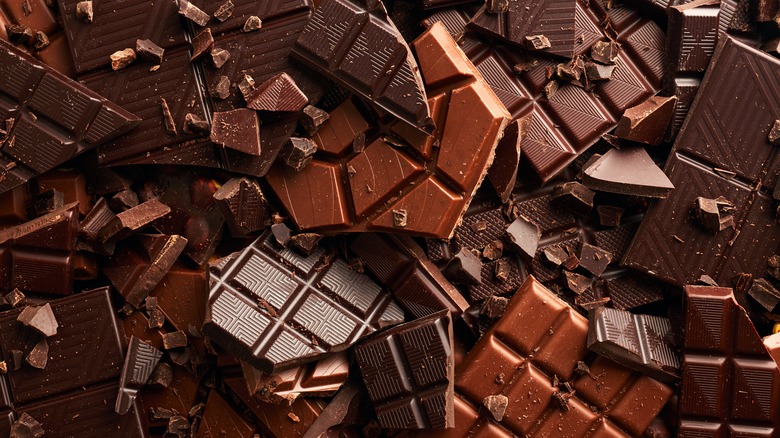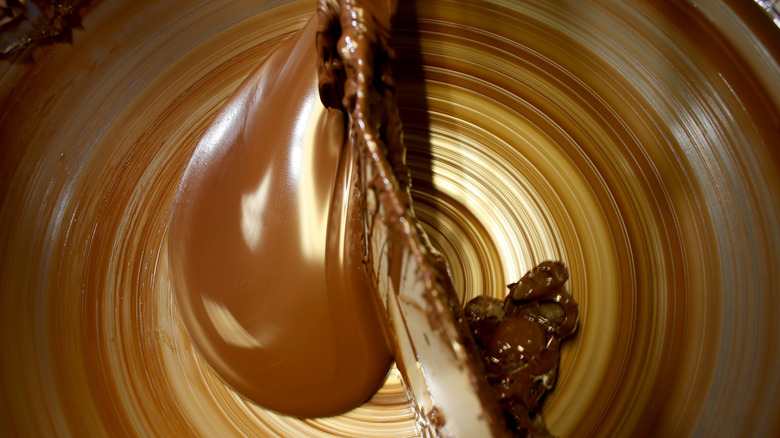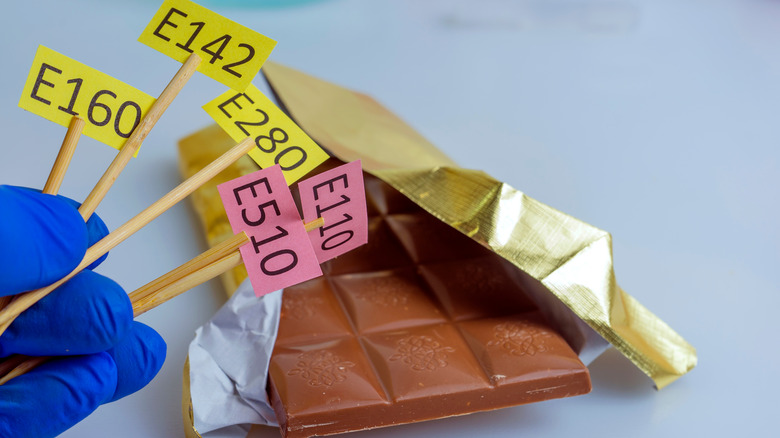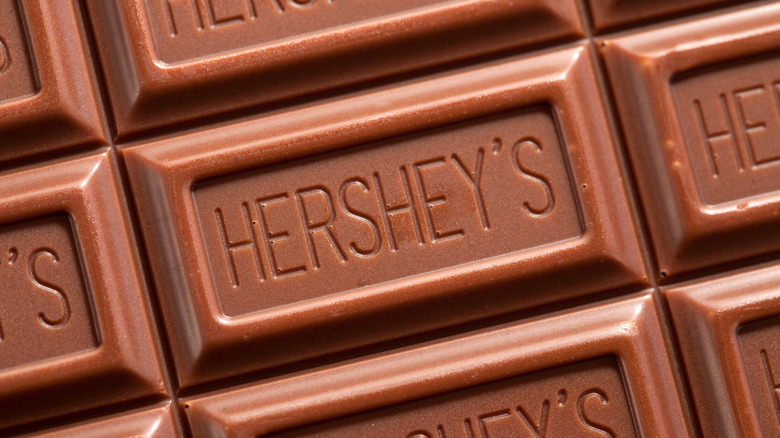What The Heck Is The PGPR Ingredient You See In Chocolate?
On the surface, chocolate seems simple. At the basic level, the rich sweet is made by processing cocoa beans and adding sugar and maybe milk into the mix. However, the science behind the confection is remarkably complicated. Anyone who bakes with chocolate knows how tricky it can be to temper or combine it with other ingredients. Working with the confection on a large scale is even more challenging, especially when pouring molten chocolate into molds or using it to coat oddly shaped candies. So, naturally (or not), quite a few things go into making most of the chocolate sold in the candy aisle — including unfamiliar additives.
If you've ever read the ingredients list of a Hershey's chocolate bar while casually popping pieces of it into your mouth, you probably came across an odd acronym: PGPR. At a time when people are being more selective about which chocolate brands are worth buying because of contaminants like lead and cadmium, discovering a strange-sounding ingredient likely raises red flags. Certain major manufacturers like The Hershey Company have likely been using PGPR since it was given the green light Stateside in 1999 — and many still do, despite previous plans to remove it from products. A part of the chocolate-making process for popular Halloween candies like Reese's, Kit Kats, and Twix (made by Mars), this ingredient isn't necessarily cause for concern. However, it is a sign of chocolate that's potentially less chocolatey, so to speak. Here's what you should know about PGPR and what it means for your chocolate.
PGPR is an emulsifier used for chocolate's consistency
To better understand what exactly PGPR is, consider emulsification — a process that helps give us delicious foods from cheese sauce to chocolate. Emulsifiers help combine and stabilize ingredients that don't mix together easily, generally because they contain fats and water. If you've ever made mayonnaise from scratch, you've witnessed this science firsthand. Oil is blended with watery ingredients and egg yolks, which contain high amounts of lecithin, an emulsifying agent. Chocolate, made by mixing together dry solids like sugar and cocoa solids and fatty cocoa butter, can benefit from emulsifiers to achieve optimal consistency during manufacturing. They can also help prevent chocolate from seizing and developing a white dusty appearance, known as blooming.
The product of a reaction between glycerol and fatty acids, PGPR, or polyglycerol polyricinoleate (say that five times fast), is an emulsifier commonly made from castor beans, soybeans, or sunflower seeds. Typically used in small amounts in combination with soy or sunflower lecithins, it makes molten chocolate a Newtonian liquid so it flows more smoothly through factory machines and onto unevenly shaped chocolate-coated candies Almond Joys. Found in other Hershey's products from Cadbury bars to York Peppermint Patties, the company's website notes that PGPR makes up less than 1% of all ingredients in its milk chocolate and improves its consistency and viscosity for pouring into molds. Additionally, Palsgaard, a PGPR manufacturer, advertises the emulsifier's impact on quality control overall in creating consistently uniform batches of chocolate.
PGPR is deemed safe by the FDA
While PGPR's name doesn't do it any favors in terms of trustworthiness, the additive is approved by the FDA for use in food. In correspondence with a Unilever representative in 2023 that defines PGPR and how it's manufactured, the federal agency confirmed that PGPR is GRAS ("generally recognized as safe") and that it can be used at amounts of up to 0.5% in chocolate products. Per the 1958 Food Additives Amendment, the emulsifier's purported safety hinges on scientific research, which many experts have conducted and reviewed.
PGPR has undergone its fair of share scrutiny since its first use in England in 1952 (via the National Confectioners Association). A series of studies in the 1950s and 1960s found that the emulsifier didn't have any adverse effects on humans when consumed in quantities significantly higher than the recommended daily intake, per the Food and Chemical Toxicology Journal. In more recent years, the European Commission requested that experts reevaluate the allowable levels of PGPR, or E476 as its classified abroad. After reviewing a two-year study on potential toxicity and carcinogenicity, the Panel on Food Additives and Nutrient Sources added to Food (ANS) recommended in 2017 that the previous allowable limits of PGPR for daily intake should actually be more than tripled, per the European Food Safety Authority Journal. Between U.S. and European authorities, there's consensus that PGPR's presence in chocolate isn't unsafe. However, that still doesn't necessarily mean it's great for chocolate quality.
Are PGPR and cocoa butter competing for space in chocolate bars?
Despite its FDA approval, PGPR's presence in chocolate hasn't been without criticism. Like many other food additives, some online ingredient watchdogs are skeptical of its use as a way of cheapening chocolate, allowing manufacturers to decrease the amount of fat used by supplementing it with PGPR. In his book "Chocolate Science and Technology," Emmanuel Ohene Afoakwa, a professor of food science and technology, notes that a very small amount of PGPR (0.1%) can be used with a smaller amount of cocoa butter (32%) to achieve a similar viscosity in chocolate as a greater amount of cocoa butter (35%). Hershey's website states that its emulsifiers aren't used as a substitute for cocoa butter or chocolate's natural fats. However, the possibility of supplementing them isn't outlandish since PGPR isn't required for the chocolate-making process. Some companies simply opt not to use it, relying fully on cocoa butter to give chocolate its signature texture. However, that might mean more expensive chocolate.
As climate change affects global cacao production, the prices of chocolate and its core ingredients have been increasing, potentially pushing manufacturers toward additives and creating a larger shift in the candy industry. In June 2024, Reuters reported that cocoa prices rose 60% in 2023 and another 88% in the first half of the year, in turn driving up the price of cocoa butter. The outlet stated that Blommer, a major cocoa producer, is responding by creating an affordable alternative to the ingredient for confectioners.
Hershey's once planned to remove PGPR from its chocolate
While Hershey's currently uses PGPR, the company once took a stance against the ingredient. In 2015, a wave of consumer demand pushed for big brands to use simpler ingredients. General Mills, Campbells, and Nestlé started shifting the production of certain foods to feature fewer artificial and highly processed ingredients in favor of natural ones. Hershey's took initiative, too, proposing a multi-year plan to remove PGPR, along with artificial flavor, from its chocolate bars and other products (via Fox Business). This process would also reportedly result in higher amounts of cocoa butter being added to Hershey's chocolate to achieve the same consistency that PGPR brought to the bar, per CBS News.
However, Hershey's chocolate bars and many other chocolate candies still feature the emulsifier on ingredient lists. (Hershey's Kisses, specifically the milk chocolate ones, didn't contain PGPR in the first place, but many other flavors of Kisses do.) It's unclear as to whether or not Hershey's eventually removed PGPR from these products and then added it back, but considering its presence nearly 10 years later, the company walked its plans back at some point.
If you prefer chocolate with simpler ingredients and more cocoa butter, certain companies like Ghirardelli and Lindt, Ina Garten's favorite chocolate brand for baking, don't contain PGPR. Some brands don't use any added emulsifiers at all. When it comes to satisfying a sweet tooth with premium chocolate, a little bit of investigation in the candy aisle goes a long way.




